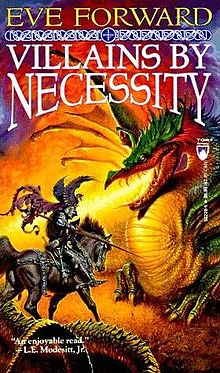If there ever is a book that defines “Hidden Gem” for me, it’s Eve Forward’s wonderful fantasy pastiche, Villians by Necessity. Published in limited numbers in 1995, the book is a trope-fuelled bonfire of the cliches of the era. We meet halfling thieves, guilded assassins, black knights, nature-loving druids, vampish sorceresses, barbarians…you get the idea (though farmboys are conspicuously absent). But, unlike the derivative, by-the-numbers epics that have given late 20th C fantasy a bad name, this book turns the standard formula on its head, plays with tropes and assumptions, and all while weaving together an excellent adventure quest that would have any D&D party rubbing their Cheeto-stained* hands with glee.
The twist is, of course, that the heroes of the story are villains – those characters that would occupy the bottom row of the D&D alignment table, that are often there to stall Our Heroes in their quests, that are usually only out for themselves and certainly not interested in saving the world, thank you very much. Yet that is exactly what they are recruited to do (by a True Neutral).
Of course, they pale somewhat in comparison to the dark antiheroes of modern standards. And assassins and thieves have always been popular fantasy heroes or sidekicks, and are usually portrayed with scruples and regulations that preclude them being truly evil. Even the cannibalistic dark-elf-like sorceress is mostly de-fanged and largely behaves herself.
But I suppose that’s why we call them “villains” rather than “evil”, because it’s a label put upon them by society, rather than who they are. When contrasted with the Heroes that are supposed to be on the side of Good, Forward makes it very clear that no-one can be painted as simplistically as that, and that everyone is somewhere along the spectrum of grey (as if the 21st C ever had sole license on that).
The problem facing this world – as represented by the six suspiciously regular and appropriately named lands that we visit – is that the forces of Good have triumphed to such a degree that Darkness has been banished for all time. And without the choice between Good and Evil, the sentient creatures of the land are robbed of free will (often violently so). Not only does that make the world a pretty boring place, but it means it is heading for a white-out – not just stagnation but complete stasis.
This isn’t a million miles from Moorcock’s premise in his Eternal Champion books that Chaos and Law need to be kept in balance or the world will either perish through complete entropy or total rigidity. Still, his champions usually end up fighting a rising tide of evil (if occasionally with chaotic help) rather than having to worry about the complete victory of Law. And yet, this victory is the end-point of most classic Epic Fantasy series, and also where our story begins (take that, Sanderson and Morgan).
The story itself is a rip-roaring adventure across six lands, questing after a series of tests that will allow the villains to return Darkness to the world. There isn’t a whole lot of realism here. Despite the point that’s being made about the unrealistic conventions of D&D-style fantasy, Forward still plays mostly within its lines. There are plenty of convenient healing potions and magic tricks to get our protagonists out of scrapes they shouldn’t survive – but such is fantasy adventure, after all, only this time it’s the forces of Good that constantly fail (though they aren’t ever incompetent, being Heroes).
I’m still not sure the libertarian premise completely works – it may work fine for these villains-with-hearts-of-gold, but what about the children devoured by monsters or orphaned by wars? What about the true psychopaths out there, are they necessary for the survival of free willed life? A laissez-faire attitude is all well and good for the competent and the strong, but shouldn’t a society look after the weak, and aren’t they better off in a world where “Darkness” is largely suppressed? Something for the sequel, perhaps…
Anyway, Villains by Necessity isn’t a philosophical treatise, it’s a unique fantasy adventure novel, and a damn fine one at that. Track a copy down, if you can!

The one time I think Darrel K Sweet works perfectly.
* Sorry, had to.
Awesome, I’ll have to start searching down a copy.
LikeLike
Pingback: Friday Round-Up: Lovecraftian Horrors on Mars, James Damore AMA, – Filip Magnus Writes